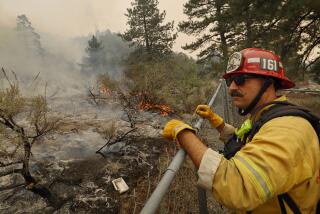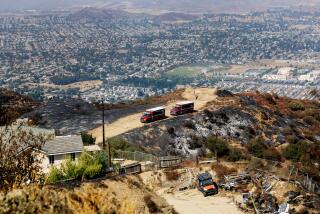Firefighters Get Edge on Alaska Blaze
- Share via
BIG LAKE, Alaska — Helped by light rains, calmer winds and cooler temperatures, firefighters continued to make gains Saturday in their battle against the wildfire that has scorched 35,000 acres in this popular recreation area.
But officials stressed that the fire was only partially contained and a long way from being controlled.
Ron DeHart, a U.S. Forest Service spokesman, said there’s no immediate danger of the fire spreading because crews are dousing small flare-ups and carving a clear perimeter around the blaze.
Firefighters expected to have the blaze at least 50% contained by today, said Katie Markin, a spokeswoman for the Alaska Division of Forestry. Authorities hope to have the area surrounded and contained by Monday night, before warmer, drier air moves in.
“We love this weather,” DeHart said. “It’s certainly cooling the fire, so we’ll be in a real good position to knock this thing down in the next two days.”
Mark Murray didn’t consider the risk of fire when he moved to Big Lake, about 50 miles north of Anchorage, several years ago. Now his house and everything in it are gone, although his wife and three children escaped safely. He had no insurance.
“I’ve been a wild-land firefighter for 18 years and a smoke jumper, and I didn’t think there was any higher risk here than anyplace else,” he said. The family is staying at a Red Cross shelter, along with about 200 other evacuees.
The blaze destroyed 320 homes, log cabins, trailers and plywood shacks, and caused an estimated $9.7 million in damage. No structures have been lost in the last two days, Markin said. There were no reports of serious injuries.
Investigators suspect the blaze, which started Tuesday and reached its peak Wednesday, was caused by fireworks.
Firefighters were also battling a second blaze about 100 miles south that had spread to 20,500 acres of wilderness by late Friday, less than a day after it was spotted. About 100 of the 1,200 firefighters battling the Big Lake blaze were diverted to the new fire, which was endangering a power line in an unpopulated area of the Kenai Peninsula, 85 miles south of Anchorage.
The escalating wildfire sprang up overnight Thursday at a logging site near Tustumena Lake. The fire is adjacent to the Kenai National Wildlife Refuge, a haven for moose, bear, salmon, and other fish and wildlife.
By Saturday, Kenai Peninsula Borough Mayor Don Gilman had asked Gov. Tony Knowles to declare the site another state disaster area.
Like the Big Lake area, the Tustumena Lake area and the Kenai National Wildlife Refuge are popular recreation sites. The region is famous for its salmon fishing. But the Kenai Peninsula fire is better separated from settlements than the Big Lake fire.
Other wildfires have struck Alaska’s more sparsely populated interior region.
A new blaze near Tok, a town about 300 miles northeast of Anchorage, was burning 400 to 500 acres one mile north of the Alaska Highway, a state official said. Two crews were battling that fire.
Fires totaling 8,000 acres and 1,800 acres were burning near Delta Junction, about 250 miles northeast of Anchorage, and were expected to merge, officials said.
More to Read
Sign up for Essential California
The most important California stories and recommendations in your inbox every morning.
You may occasionally receive promotional content from the Los Angeles Times.













